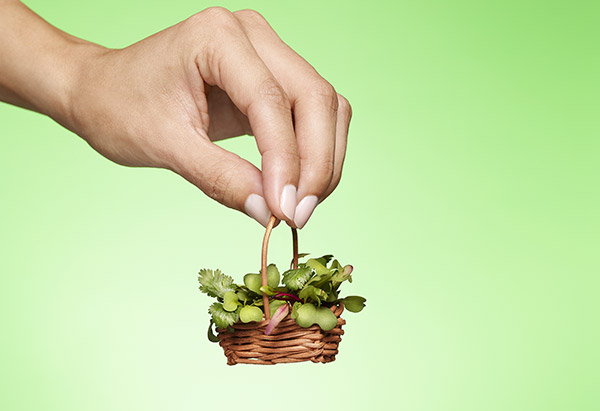The Mighty Power of Mini Greens
These seedlings prove that good things can come in extremely small packages.

Photo: Adam Voorhes
Every few years it seems like a new leafy veggie becomes the darling of the farmers' market—first Swiss chard, then kale, and now...microgreens. Harvested when they're just seven to 14 days old, these pint-size leaves can be far more nutrient dense than their full-grown counterparts, according to a recent study done in collaboration with the U.S. Department of Agriculture and published in the Journal of Agricultural and Food Chemistry. "Plants use stored nutrients to grow, so plucking the tiny seedlings early means they still have high levels of vitamins and minerals," says study coauthor Zhenlei Xiao. Keep in mind, though, that these mini-me's lack the fiber found in mature plants, so they should supplement the greens you already eat, not replace them. The best part? Thanks to the concentrated flavor of these five diminutive standouts, they elevate meals in taste as well as nutrition.
This fragrant green contains 11 times more lutein and zeaxanthin (nutrients that can reduce the risk of cataracts and age-related vision loss) than the same amount of mature cilantro.
Best with...Latin dishes.
Nicolas Bour, executive chef at Rancho Bernardo Inn in San Diego, suggests a twist on guacamole: Mix 3 ripe avocados with 1 chopped heirloom tomato, ½ chopped red onion and the juice of 2 limes. Add 4 Tbsp. micro cilantro, 8 tsp. olive oil and 4 ounces chilled baby shrimp. Salt to taste; top with ¼ ounce micro cilantro and serve with chips. Serves 4.
These slightly bitter, heart-shaped leaves outshine full-grown cabbage with roughly 260 times the beta-carotene (a precursor to vitamin A that can help protect eyesight) and more than 40 times the vitamin E.
Best with...sweet side dishes, like this simple slaw from Bour.
Combine 2 cups each julienned napa cabbage, red endive, and Fuji apple with a generous dash each of grapeseed oil and sherry vinegar. Sprinkle with ¼ cup micro red cabbage. Serves 4.
Next: The small (spicy) green packed with vitamin C
Micro Cilantro
This fragrant green contains 11 times more lutein and zeaxanthin (nutrients that can reduce the risk of cataracts and age-related vision loss) than the same amount of mature cilantro.
Best with...Latin dishes.
Nicolas Bour, executive chef at Rancho Bernardo Inn in San Diego, suggests a twist on guacamole: Mix 3 ripe avocados with 1 chopped heirloom tomato, ½ chopped red onion and the juice of 2 limes. Add 4 Tbsp. micro cilantro, 8 tsp. olive oil and 4 ounces chilled baby shrimp. Salt to taste; top with ¼ ounce micro cilantro and serve with chips. Serves 4.
Micro Red Cabbage
These slightly bitter, heart-shaped leaves outshine full-grown cabbage with roughly 260 times the beta-carotene (a precursor to vitamin A that can help protect eyesight) and more than 40 times the vitamin E.
Best with...sweet side dishes, like this simple slaw from Bour.
Combine 2 cups each julienned napa cabbage, red endive, and Fuji apple with a generous dash each of grapeseed oil and sherry vinegar. Sprinkle with ¼ cup micro red cabbage. Serves 4.
Next: The small (spicy) green packed with vitamin C



